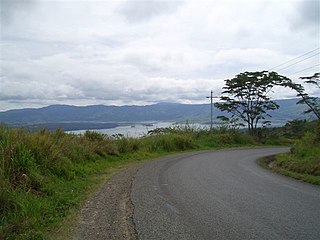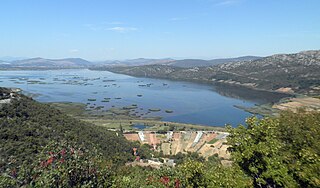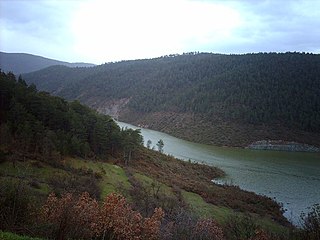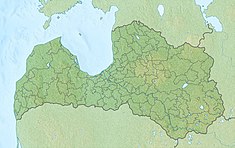
The economy of Latvia is an open economy in Europe and is part of the European Single Market. Latvia is a member of the World Trade Organization (WTO) since 1999, a member of the European Union since 2004, a member of the Eurozone since 2014 and a member of the OECD since 2016. Latvia is ranked the 14th in the world by the Ease of Doing Business Index prepared by the World Bank Group. According to the Human Development Report 2011, Latvia belongs to the group of very high human development countries. Due to its geographical location, transit services are highly developed, along with timber and wood processing, agriculture and food products, and manufacturing of machinery and electronic devices.

Riga Hydroelectric Power Plant is located just beyond Riga's southern border. It is geographically located in the town of Salaspils. Total installed power generating capacity is 402 MW. There are six generators, two transformers and two 330 kV power lines.

Eesti Energia AS is a public limited energy company in Estonia with its headquarters in Tallinn. It is the world's biggest oil shale to energy company. The company was founded in 1939. As of 2014, it operates in Estonia, Latvia, Lithuania, Finland, Jordan and Utah, United States. In Estonia, the company operates under the name Eesti Energia, while using the brand name Enefit for international operations. The main raw material for energy production – oil shale – is extracted from mines located in Eastern-Estonia and owned by the company. The group of Eesti Energia has three main operation areas: electricity generation, shale oil production, and sale and distribution of electricity. Its shares are owned by the Government of Estonia.

The Drop Hydro Power Station is a Pacific Blue hydroelectric power station on the Mulwala Canal, near Berrigan, New South Wales, Australia. It has one turbine, with a generating capacity of 2.5 megawatts (3,400 hp) of electricity.

Aiviekste is a river in Latvia. It begins at Lake Lubāns and drains into the Daugava. Aiviekste is the largest tributary of Daugava in Latvia. Aiviekste, along with the Pededze, forms the unofficial border between two historical Latvian regions Vidzeme and Latgale, although the administrative border was slightly different. The river is 114 kilometers long, with annual drainage 1.81 km³. Aiviekste is about 10-12 thousand years old, formed at the end of the last ice age and nearly after the ice age. Nearly a quarter of the river's flow is unregulated, but most of the river has been excavated, including with explosions.

Yonki Dam is an earth-fill embankment dam over the Ramu River that supports the Ramu 1 hydroelectric power plant and the Yonki Toe of Dam power plant.
Latvenergo is a state-owned electric utility company in Latvia. Latvenergo Group provides energy supply services in the Baltics.

Hydroproject is a Russian hydrotechnical design firm. Based in Moscow, it has a number of branches around the country. Its main activities are design of dams, hydroelectric stations, canals, sluices, etc.

The Čapljina Pumped-Storage Hydroelectric Power Plant is a pumped-storage hydroelectric power plant (PSHPP) or pumped hydroelectric energy storage power plant (PHESPP) type of hydroelectric power plant, whose powerhouse is situated underground near Svitava, in Bosnia and Herzegovina. It's one of country's largest hydroelectric power plants of any type, having an installed electric capacity of 420 MW.

The Ķegums Hydro Power Plant is the oldest hydropower plant on the river Daugava and the third largest in Latvia located in Ķegums. The complex consist of two power plants. The first plant was built from 1936 to 1940. The plant was totally renovated from 1998 to 2001, including replacement of four hydroelectric sets with a nominal output of around 65 MW.

The Pļaviņas Hydroelectric Power Station is the largest hydroelectric power plant in the Baltics and one of the biggest in the European Union. It is located in Aizkraukle on the Daugava River. It has ten individual water turbines with an installed total capacity of 894 MW.
The Daugavpils hydroelectric power station was a proposed hydro power project in Daugavpils, Latvia. It was to have 10 individual turbines with a nominal output of around 30 MW which were to deliver up to 300 MW of power.

Aizkraukle Municipality is a municipality in Vidzeme, Latvia. The municipality was formed in 2001 by merging town Aizkraukle and Aizkraukle Parish the administrative centre being Aizkraukle. The population in 2020 was 8,024.

Aiviekste Parish, is an administrative unit of Aizkraukle Municipality, Latvia. As of 2011 population of Aiviekste Parish is 818 people. Latvian law defines Aiviekste Parish as belonging partly to the Vidzeme region and partly to Latgale.

Çınarcık Dam is a rock-fill dam on the Orhaneli River about 30 km (19 mi) east of Mustafakemalpaşa in Bursa Province, Turkey. It serves several purposes to include power, irrigation, flood control and municipal water supply to the city of Bursa. The dam was constructed between 1996 and 2002. Construction of the Uluabat Hydroelectric Station, which the dam supplies water to, began in 2006 and it was commissioned in 2010. The 125 m (410 ft) tall dam diverts water north through an 11.27 km (7.00 mi) long tunnel where it reaches the power station on the southern bank of Lake Uluabat. Water discharged from the 100 MW power station then enters the lake. The dam and power station are owned by the Turkish State Hydraulic Works.

The Ilha Solteira Dam is an embankment dam on the Paraná River near Ilha Solteira in São Paulo, Brazil. It was constructed between 1967 and 1973 for hydroelectric power production, flood control and navigation.

The Baksan Hydroelectric Power Station is a small hydroelectric power station on the Baksan River in Atazhukino, Baksansky District, Kabardino-Balkaria, Russia. It is one of the oldest hydroelectric plants in Russia. It is owned by RusHydro.
The Burç Bendi Dam is a gravity dam on the Göksu River, near the village of Burç in Adıyaman district, Adıyaman Province, Turkey. Its primary purpose is hydroelectric power generation and it supports a 27.9 MW run-of-the-river power station. Construction on the dam began in January 2008 and it was fully operational by 3 November 2010. The 57 m (187 ft) tall concrete dam withholds a reservoir of 26,600,000 m3 (21,600 acre⋅ft). Water is diverted through a 536 m (1,759 ft) long tunnel to the power station downstream which contains three 9.3 vertical Kaplan turbine-generators. It is owned and operated by ČEZ Group.
















